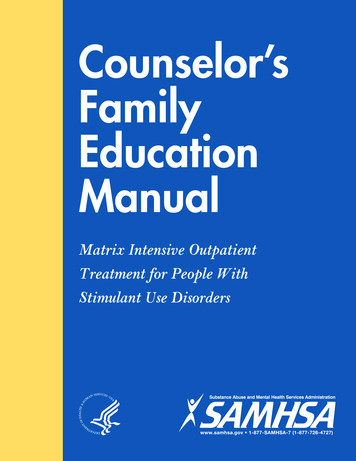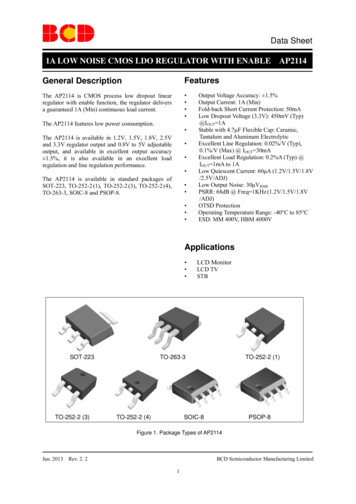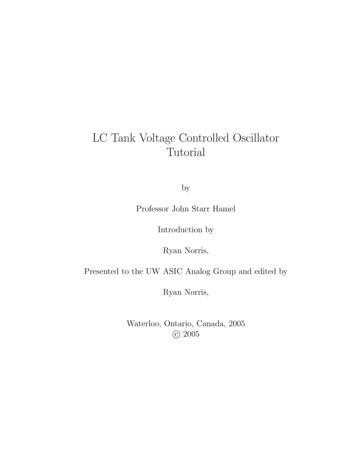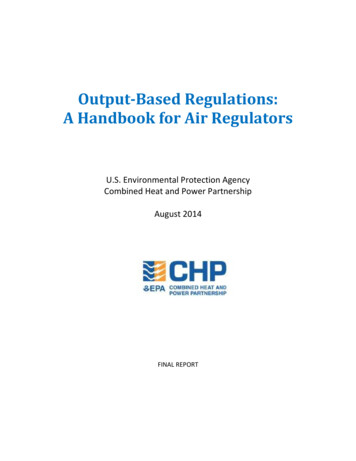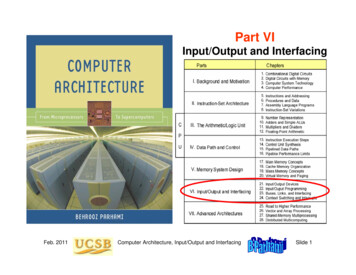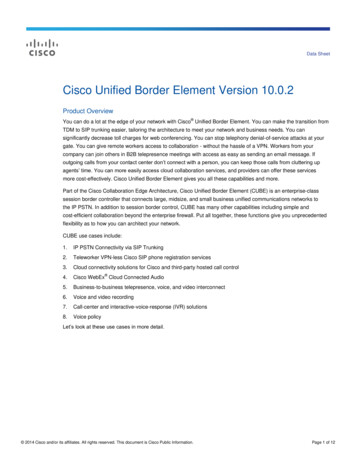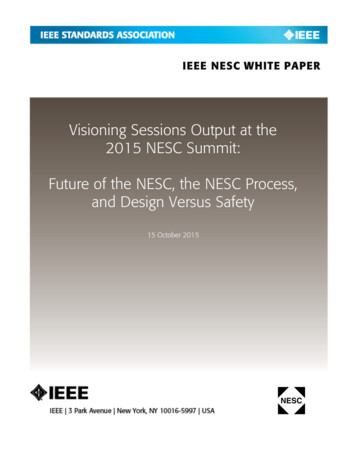
Transcription
IEEE NESC WHITE PAPERVisioning Sessions Output at the2015 NESC Summit:Future of the NESC, the NESC Process,and Design Versus Safety15 October 2015
nue,NewYork,NY10016- ‐5997,USACopyright ated.PDF:ISBN978- ‐0- ‐7381- ‐xxxx- ‐xSTDVxxxxxPrint:ISBN978- ‐0- ‐7381- ‐xxxx- .ieee.org/web/aboutus/whatis/policies/p9- orderIEEEPressPublications,call1- ‐800- ‐678- ‐IEEE.FindIEEEstandardsandstandards- orgiiCopyright 2015IEEE.Allrightsreserved.
EE- - n- - ghtsonareasonableornon- eforthestatementsandopinionsadvancedinthisWork.
NESCSummitVisioningWhitePaperContentsExecutive Summary 3Introduction 5NESC’s Future . .6NESC’s Processes . . 8Design versus Safety .10Conclusions/Next Steps . . . .12Appendix . . .13ivCopyright 2015IEEE.Allrightsreserved.
A White PaperVisioning Sessions Output at the 2015 NESCSummit:Future of the NESC, the NESCProcess, and Design Versus Safety“[An evolving grid] means a lot more information technologies, a lot more connections, a lotmore components on the system.How do we look at those components from a safety perspective?I encourage a broad, thought-provoking exercise on where we want to go in the future as the gridcontinues to evolve.”Pat Hoffman,Assistant Secretary for the Office of Electricity Delivery and Energy Reliability,U.S. Department of EnergyKeynote address to NESC Summit, 28 April 2015
NESCSummitVisioningWhitePaperEXECUTIVE SUMMARYTo help ensure the continued relevance of the National Electrical Safety Code (NESC ) within thecommunications and power industry and the workers it serves, NESC leadership decided in 2014 to reviewthe organization’s future, its processes, and ongoing issues such as whether it should emphasize designcriteria and construction versus the standing 100 years of safety. A review of this nature was deemedparticularly important given the rapid evolution of new technologies and other changes affecting NESC’sdomain. The 2015 NESC Summit held 28 29 April 2015, in Alexandria, Virginia, offered an opportunityto discuss these issues and debate the future of the NESC.The summit included visioning sessions that focused on the aforementioned three topics: NESC’s future,its processes, and the question of whether it should address safety alone or include design. In recognitionof the diversity of its stakeholders and the need for their support for any resulting changes proposed for theNESC, the visioning sessions held at the 2015 NESC Summit were open to all attendees. Participants inthe visioning process were asked to respond to specific questions on the three topics, which aresummarized as follows:§ § § NESC’s Future: What should the NESC look like in 2037 or 2042? What subjects need to beexamined for inclusion in the NESC’s future?NESC’s Process: Does today's today’s NESC process, supporting a current 5- ‐year revision cycle,serve adequately to address rapidly developing technology advancement and keep the NESCrelevant and viable?NESC’s Focus on Design Versus Safety: Is the NESC being considered by utilities as a designguide, a safety code, or both? Should it be used as only safety or shall we accept and embrace theconcept that the code is also a design code to many users?The ensuing, wide-ranging discussions that resulted were paraphrased and captured in notes by IEEE staff.Although an attempt was made to capture common themes among the comments, the intent was togenerate open discussion and record the diversity of viewpoints expressed. The visioning sessions were notdesigned to reach consensus or quantifiable conclusions.This white paper, therefore, is intended to articulate the drivers for the visioning sessions, capture theflavor and diversity of the three ensuing discussions, and serve as a springboard for next steps that mayresult in practical actions.The first question, on NESC’s future, elicited comments relevant to the other two questions. Whether tofocus on safety or include design guidelines remains a debatable point that is central to NESC’s future.Participants commented that the relatively recent revisions to the NESC may have blurred the line betweensafety versus design. Careful consideration must be given to any proposed changes to the NESC’s currentscope and purpose, as enacting change will require significant time and effort. The impact of changes onend users must also be considered, which is particularly true if the NESC includes design guidelines forenvironmental loads, because public utility commissions or other regulatory authorities often requireutilities to implement all or, in special cases, parts of the NESC. Adding design guidelines, in someutilities’ view, may drive higher costs without necessarily providing clear stakeholder, customer, or2Copyright 2015IEEE.Allrightsreserved.
NESCSummitVisioningWhitePapershareholder value. Participants said that crafting a Vision Statement might serve to articulate a proactivefuture for NESC.In terms of NESC’s process, the Summit discussion noted the history of the revision cycle—at one time itwas three years; today it is five years. Comments during the breakout session ranged from a suggestedreturn to the three-year cycle due to communications technology improvements such as e-mails, text, andInternet, to different or varying length cycles for specific parts of the NESC. A variety of means foraddressing rapidly-evolving technologies in a timely manner were proposed. Changes in process mightinclude scope and content change and/or expansion or the use of existing or new working groups and/orsubcommittees to address this challenge. Participants suggested that NESC’s content and presentationmight benefit from the use of new technologies—e.g., digital publishing—to make it more accessible andeasier to use.On the safety vs. design question, which attendance statistics indicate drew the most participation,comments varied considerably. Some participants noted that design guidelines for environmental loads hadbeen expanded over the years, potentially fueling the debate over whether safety or design should beemphasized. Others suggested that perhaps the two concepts (design and safety) should be clearlydistinguished from each other in the NESC’s content. This might facilitate the ability of state public utilitycommissions and other regulatory agencies to provide clear direction to utilities by potentially directing or,in some cases, possible mandating that utilities follow the NESC for safety, while making adherence to itsdesign guidelines voluntary. A suggestion was also made that the NESC focus solely on safety and that itfind another relevant Standards Development Organizations (SDOs) to undertake the role of providingdesign guidelines.The post-event survey (with an approximately 50% response rate) showed that 92% of attendees weresatisfied with the summit and 78% were satisfied with the visioning sessions. Nearly three of fourattendees (72%) said that they attended the summit to “provide input into the future of the NESC,” whichmay reflect intense interest in the topics discussed in the inclusive visioning sessions.Next steps remain to be determined. The level of interest and the diversity of the views expressed in thevisioning sessions suggest a need to reach out to the widest, most representative set of stakeholders formore structured discussions that lead to consensus on possible changes to the NESC’s future, its processes,and its primary focus.3Copyright 2015IEEE.Allrightsreserved.
NESCSummitVisioningWhitePaperGENERAL INFORMATIONThe health of an SDO requires it to periodically reassess its mission, direction, processes, and any ongoingissues. This is particularly important for one with the responsibility for producing the widely acceptedNESC, which has a very broad impact, affecting the entire country. As the world changes, particularly interms of power-related technology development, the NESC must examine its focus, its processes, and itsfuture direction to help ensure its effectiveness and relevance to the industry it serves, as well as tobroaden its support and continue to earn the dedication of its volunteers and stakeholders.Over the course of its approximately 100-year history, the effort now known as the National ElectricalSafety Code (NESC) has taken different forms, with different processes and purposes. Since 1914 theNESC has had different homes—first under the National Bureau of Standards (1914 1972) and todayunder the Institute of Electrical and Electronics Engineers (IEEE). The code itself has been written andpresented in discreet parts and it has existed, as it is today, as a unified document. Its content has alwayscontained some design guidelines alongside its focus on safety and this potentially dual scope remains atopic of interest to stakeholders. The NESC’s revision cycle moved to every three years in the late 1970sand, in 1997, it moved to five years.At the NESC Vision and Scenario Planning Session held 13 February 2014 in Rancho Cucamonga, CA,the NESC Main Committee, the NESC Executive Subcommittee, and Subcommittee chairs met to discusshow to address the need for a reassessment of the NESC’s focus, processes, and future. The visioningsessions held in April 2015—the focus of this white paper—was one outcome. The intent of the NESCleadership was to push participants to examine the NESC’s purpose, processes, and future for the longterm benefit of both current and future stakeholders and end users. The intent of the summit was to movebeyond possible parochial, short-term biases to achieve a coherent 21st century vision.In recognition of the diversity of stakeholders that do not sit on the NESC’s Main Committee, includingorganizations and companies, the NESC leadership decided it needed a more open, collaborative processso that potential changes to the NESC are discussed, articulated, and supported by the most inclusive set ofstakeholders.Thus, this year’s summit opened discussion and comment on NESC’s future, its processes,and the design vs. safety issue to the broader audience of approximately 106 attendees. To enable attendeesto participate in more than one topic discussion, two breakout sessions were held for each of the threetopics of interest.This white paper is intended to capture the context, process, discussion, and outcomes from the summitworkshops that focused on these three areas as a record of our deliberations and serve as a benchmark forfurther discussions and actions.4Copyright 2015IEEE.Allrightsreserved.
NESCSummitVisioningWhitePaperTHE NESC’S FUTUREThe questions addressed in this visioning session included the following:“What should the NESC look like in 2037 or 2042? What subjects need to be looked at for inclusion in theNESC’s future?”Two sessions engaged approximately 50 participants and produced more than 100 comments, whichmoderators organized into eight key themes due to perceived commonalities. Although reaching consensusor quantifiable conclusions was not the intent, the level of interest in key themes reflected in the bulletpoints below may serve to inform future discussions. (The numbers in parentheses below indicate thenumber of related comments offered on each key theme.)For visual charts that convey the same data, see the Appendix, “NESC Summit 2015: Visioning Sessions.”§ § § § § § § § Content expansion or change (27)Product consumption (21)Code usage and implementation (16)Collaborating with diverse bodies (12)Process (10)Safety (9)Engaging next-generation engineers (5)Target Audience (4)Participants’ comments reflected broad interest in pursuing a proactive vision statement “to be responsiveto evolving technology while respecting [NESC’s] history” and to help articulate the NESC’s direction andaspirations for decades to come.Many comments tended to combine the session’s three main topics (in this case, future and process) andmultiple key themes (for instance, content change, product consumption, and next-generation engineers).Not only should the NESC evolve to more rapidly address evolving technologies, some said, it should alsobecome more accessible, visual, and searchable—essentially, more user friendly—by producing a digitaledition, particularly for next-generation engineers.Collaboration with non-NESC organizations was also established as a key theme, measured by commentsin the double digits.As the visioning sessions were designed to generate discussion, rather than consensus or conclusions, asampling of comments on key themes by quantity or perceived relevance are presented as follows:§ Content expansion or change:“Develop rules for addressing emerging technologies, including robotics, sensors, drones, solar,communications, microgrids, energy storage, Internet of Things.”“The primary purpose of the code is to protect people, public and workers. Should it be expandedto address the safeguarding of assets/facilities/property?”5Copyright 2015IEEE.Allrightsreserved.
§ NESCSummitVisioningWhitePaperProduct consumption/Content delivery:“Create a digital NESC edition that’s more accessible, searchable, and possibly update-able.”“Enable public safety as the public interacts more with the grid.”§ Code usage and implementation:“Flexibility” was mentioned with some frequency, but in two contexts: 1) a concern that safepractices not get lost as the NESC provides “flexibility” in how to achieve it; and 2) “flexibility”of the NESC’s format was mentioned twice but not defined.§ Collaborating with diverse bodies:“Bring in stakeholders who use/apply the NESC.”“We’ll need outside experts who can bridge the gap to understanding IT, cybersecurity, etc.”“Consider how other, related groups see the future.”§ Engaging next-generation engineers:“Content should be searchable, add images/video. Augmented reality (AR) might be a useful tool.”6Copyright 2015IEEE.Allrightsreserved.
NESCSummitVisioningWhitePaperNESC’S PROCESSESThe question posed to the visioning sessions on process was as follows:“Does today’s NESC process, supporting a current five- ‐year revision cycle, serve adequately to addressrapidly developing technology advancement, and keep the NESC relevant and viable?”Two sessions, with approximately 29 total participants, produced 35 comments, which moderatorsorganized into six key themes. (The numbers in parentheses indicate the number of related commentsoffered on each key theme.)§ § § § § § Content expansion (13)Timeline changes (10)Amendments (7)Modernization (2)Confusion (2)Adoption (1)The question of whether to change the current, five-year revision cycle generated a number of comments.Some said longer, some said shorter, some said five years is just right.Sometimes a topic drew diametrically opposed views. One participant suggested splitting the code intoparts, possibly to enable different revision cycles for each. Another participant said that splitting the codewould create confusion.Salient comments tended to focus on the NESC’s ability to address evolving technologies in a timelymanner and various mechanisms to do so. The “content expansion” key theme appeared to mean the swiftconsideration and possible inclusion of new or evolving technologies. Comments on speeding up theprocess—particularly for the consideration of emerging technologies—asked whether working groupsshould develop pre-proposals, new subcommittees devoted only to new content should be created, or theTentative Interim Agreement (TIA) process should be revised.The third key theme—amendments—was linked to the first two, as one representative comment noted thatthe TIA process does not include new technology, but asked whether it should.The fourth key theme—modernization (of NESC processes, content, and/or presentation)—drewcomments on whether existing or future technologies could aid the quest for a speedier, more nimbleprocess for considering content changes and/or presenting the code.A sampling of comments on key themes by quantity or perceived relevance is presented as follows:§ Content expansion:“Current procedures don’t allow NESC to include new technology quickly enough.”“Do we need another subcommittee that only looks at new content that needs to be addressed?”Alternatively, “delegate new technologies” [Presumably to other safety-focused groups]7Copyright 2015IEEE.Allrightsreserved.
NESCSummitVisioningWhitePaper“Economic or business interests should not be driving the code.”§ Timeline changes (i.e., deviation from five-year revision cycle):“Can the three-year cycle be shortened? It makes the revision process ongoing.”“Lengthen it, because travel and projects take time.”“Five years is the least-worst option.”“Certain sections of NESC are static, others dynamic. Could we split the code and publish sectionsindependently of each other?”“Splitting the code is confusing.”§ Amendments:“Should the TIA process be used to address emerging technologies?”“The code currently allows for quick changes regarding safety concerns.”8Copyright 2015IEEE.Allrightsreserved.
NESCSummitVisioningWhitePaperSAFETY VS. DESIGNBecause the NESC has historically contained some design criteria, which arguably have been expanded inrecent revision cycles, participants were asked to weigh the following two-part question:Is the NESC being considered by utilities as a safety code or should we accept that it is also being used asa design code?Two sessions, with approximately 75 total participants, produced 126 comments, which moderatorsorganized into six key themes. (The numbers in parentheses below indicate the number of relatedcomments offered on each key theme.)§ § § § § § Scope increase (36)Scope change (34)Reliability (25)Risk/cost (12)Resiliency (9)Partnership (6)Though not identified as a key theme by staff at the time, the safety vs. design issue generated multiplecomments on two topics, which were captured in the key themes of “Scope Increase” or “Scope Change.”These comments would be difficult if not inappropriate to attempt to quantify, but they ran the gamutfrom insistence that the NESC maintain a clear, unambiguous focus on safety to an acknowledgement thatit currently includes elements of design guidelines—which some felt was just the right amount—to theneed to consider that the two topics overlap and cannot be wholly separated.The potential costs of safety measures and expanding the NESC’s current level of design guidelines shouldbe carefully considered, several participants said.Under the key theme of “Reliability,” comments seemed to recognize that, at least to some degree, designand safety go hand-in-hand: “Contractors rely on utilities for proper construction guidelines in order toprotect contractor employees (safety).”A sampling of comments on key themes by quantity or perceived relevance is presented as follows:§ Scope increase:“Extreme [weather/environmental] events have driven inclusion of more design criteria.”“Design criteria would clutter NESC’s basic safety focus.”“NESC is neither design oriented nor just safety, but in between.”“The NESC needs to include minimum design criteria as guidance, while allowing utilities todefine their own special considerations” for local environmental loading conditions.§ Scope change:9Copyright 2015IEEE.Allrightsreserved.
NESCSummitVisioningWhitePaper“OSHA is looking over our shoulder, so we need to change.”“NESC could reference other standards and guides, and remove design criteria (e.g., equations).”Differentiating where safety ends and design criteria’s safety impacts begin can be difficult todiscern. [Paraphrasing of several comments]“Specifically state that the NESC is not a design document.”§ Reliability:“Contractors rely on utilities for proper construction [guidance], to protect the safety of acontractor’s workers.”“Utilities may have an issue with NESC dictating reliability vs. resiliency measures and find thatthey drive excessive costs leading to rate increases.”“The NESC is not the document to drive the improvement of reliability/resiliency.”“Reliability is covered by other IEEE standards,” thus to include it in the NESC is redundant.§ Risk/cost:“When it costs money to provide safety, how do we determine the point of sufficient safety?”“Regulators don’t always understand the trade-offs and balance between safety and cost.”§ Resiliency:“Reliability and resiliency are addressed in other standards.”“If utilities lose power, people may die.”§ Partnership:“NESC needs to go to ASCE for more complete design criteria” or rely on it to provide designcriteria [removing it from NESC’s scope].10Copyright 2015IEEE.Allrightsreserved.
NESCSummitVisioningWhitePaperCONCLUSIONS/NEXT STEPSWith the general, diverse discussions that resulted from the April 2015 visioning sessions in hand, theNESC leadership will determine whether a formal process for consideration of potential changes in itspurpose, processes, and future should be enacted.As a beginning, the NESC Main Committee met immediately following the conclusion of the NESCSummit. Three task forces were formed (with leads identified) with a purpose of writing brief scopestatements, including recommendations for further NESC Main Committee consideration. The task forcesare organized as follows:§ Emerging Technology TopicsDevelop a scope, purpose, and gap analysis§ Safety vs. DesignResiliency as it affects the NESC§ Fast Track/Streamlined ProcessIdentify steps for a fast-track process, without losing the foundationThis effort will likely involve outreach to a truly representative group of stakeholders and organizeddiscussion designed to achieve consensus and quantifiable conclusions on changes to the NESC’s purpose,processes and future.NOTE— To provide comments on the contents of this white paper, please submit them to Sue Vogel,s.vogel@ieee.org.11Copyright 2015IEEE.Allrightsreserved.
NESCSummitVisioningWhitePaperAPPENDIX:12Copyright 2015IEEE.Allrightsreserved.
NESCSummitVisioningWhitePaper13Copyright 2015IEEE.Allrightsreserved.
Over the course of its approximately 100-year history, the effort now known as the National Electrical Safety Code (NESC) has taken different forms, with different processes and purposes. Since 1914 the NESC has had different homes—first und


